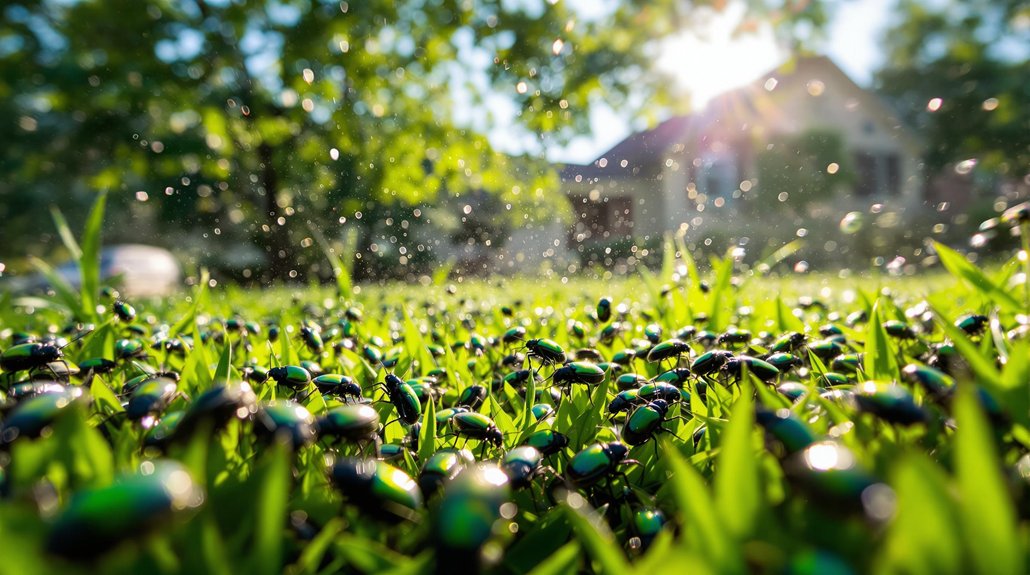Seeing more bugs after spraying in Round Rock, TX, can happen for several reasons. Insects may emerge after treatment, looking for food or escaping chemicals. Residual sprays might still be working, causing bugs to remain active. Weather, especially humidity, can increase bug populations too. Mistakes during application can lead to areas being missed. To better understand these factors and how to tackle the issue, there’s more helpful information available.
Key Article Highlights
- Increased insect activity may result from bugs emerging from hiding after treatment, seeking food or escaping chemical effects.
- High humidity in Round Rock can boost insect reproduction, causing a spike in visible bug populations post-spraying.
- Residual chemicals may remain effective, leading to continued insect activity as they interact with environmental factors.
- Habitat disruption from spraying can eliminate natural predators, allowing pest populations to rebound quickly.
- Untreated neighboring properties can serve as sources of reinfestation, making comprehensive pest control necessary.
Understanding Pest Behavior After Treatment
When pest control treatments are applied, it’s common for homeowners to wonder how bugs will react afterward. Insects may initially seem more active, causing concern. This behavior can be linked to their pest life cycles. Many pests have specific stages of development, and after treatment, they might emerge from hiding places. They could be looking for food or escaping the effects of the spray. Understanding insect behavior during and after treatment is key. Some bugs may show increased activity as they attempt to survive, while others may succumb to the treatment gradually. This phase can be frustrating, but it’s a normal part of managing pests effectively. Barrier sprays can also aid in reducing the population and preventing future infestations, while exclusion methods are essential in addressing potential entry points for pests. Routine inspections help ensure that the treatment remains effective over time. Homeowners should remain patient as the treatment takes effect over time.
The Role of Residual Chemicals
Residual chemicals play a big role in pest control after spraying. These chemicals stick around for a while, affecting how bugs behave even after the initial treatment. Understanding how long they last and their impact on insects can help residents know what to expect. Additionally, the use of residual sprays is crucial in maintaining a pest-free environment in Round Rock homes.
Chemical Persistence Explained
How long do chemicals linger after spraying? The answer hinges on chemical breakdown and pesticide longevity. After a treatment, some pesticides can remain effective for days, weeks, or even longer, depending on their formulation and environmental conditions. Factors like temperature, humidity, and sunlight play a big role in how quickly these chemicals degrade. If the weather is hot and dry, for example, chemical breakdown may happen faster. On the other hand, cool and damp conditions can extend the life of the pesticide. This lingering presence can lead to continued insect activity, as bugs may not be immediately affected. Understanding this persistence helps homeowners grasp why they might still see pests after an initial spray.
Impact on Insect Behavior
After pesticide application, the lingering chemicals can greatly influence insect behavior. These residual chemicals can alter how insects respond to their environment. For example, certain substances may boost insect attraction to treated areas, making them more likely to gather there. This can lead to an increase in visible bug populations, even after spraying. Additionally, the behavioral responses of insects might change as they navigate through the chemical-laden environment. Some insects may become confused or disoriented, leading them to new places they wouldn’t normally explore. This shift in behavior can create the illusion of a bug explosion, as insects adapt to the presence of these chemicals. Understanding these dynamics helps explain the unexpected rise in insect activity post-treatment.
Environmental Factors Influencing Bug Activity

Environmental factors play a big role in bug activity after spraying. Seasonal changes, weather conditions, and humidity levels can all affect how bugs behave. Additionally, the way habitats change from spraying can impact where bugs choose to live and thrive.
Seasonal Changes Impacting Activity
As temperatures shift with the seasons, bug activity in Round Rock, TX can fluctuate markedly. Seasonal changes play a vital role in pest migration and the patterns in which bugs become active. Different bugs respond uniquely to these shifts, influencing their behaviors and populations.
- Spring Awakening: Many pests emerge from winter hibernation, increasing their presence.
- Summer Surge: Warmer temperatures often lead to a spike in bug activity and reproduction rates.
- Fall Migration: As temperatures cool, certain pests may migrate or seek shelter, impacting local populations.
Understanding these seasonal patterns helps residents anticipate and manage bug activity, especially after spraying efforts. Recognizing how seasonal changes affect pest behavior can lead to better pest control strategies.
Weather Conditions and Humidity
Weather conditions and humidity greatly affect bug activity in Round Rock, TX. High humidity levels create a perfect environment for many insects. This moisture allows them to thrive and reproduce more quickly. When the weather fluctuates, bugs can become more active, especially after rain or storms. These changes can lead to sudden spikes in insect populations, even after spraying. Additionally, if the humidity drops considerably, some bugs may seek shelter indoors, making them more noticeable. Understanding these weather patterns helps explain why residents might see more bugs despite recent pest control efforts. Maintaining awareness of local humidity levels and weather fluctuations can provide valuable insights into bug behavior.
Habitat Alterations From Spraying
While spraying for pests aims to reduce insect populations, it can also lead to significant habitat alterations that affect bug activity. Habitat disruption from the chemicals used can change the local environment, making it less suitable for certain insects. This disruption may cause some pests to relocate, seeking refuge in nearby areas, which can lead to an increase in their presence.
- Spraying can kill off natural predators, allowing pest populations to rebound.
- Changes in vegetation can create new breeding grounds for bugs.
- Some insects may adapt and thrive in altered habitats, increasing their numbers.
Understanding these factors helps explain why there may be more bugs after spraying in Round Rock, TX.
The Impact of Seasonal Changes

Seasonal changes play a significant role in the bug population in Round Rock, TX. As temperatures fluctuate throughout the year, pests respond accordingly. In warmer months, many insects thrive, leading to increased activity and reproduction. This can result in noticeable pest migration, as species move in search of food and shelter. After spraying, homeowners may see a temporary decline in bugs, but seasonal changes can quickly bring them back. As temperatures drop, some pests may seek refuge indoors, making it seem like there are more bugs after treatment. Understanding these patterns helps residents anticipate pest activity and manage expectations, emphasizing the need for ongoing pest control efforts throughout the year.
Potential Reinfestation Sources
Pests can easily reinfest a home if the sources of their return are not identified and managed. Understanding potential reinfestation sources is essential for homeowners in Round Rock, TX. Common reinvasion pathways often include:
- Cracks and crevices: Pests can slip through tiny openings in walls and foundations. Implementing insect growth regulators can help manage these pests effectively.
- Outdoor areas: Overgrown vegetation and clutter can serve as pest reservoirs, attracting bugs close to the home.
- Neighboring properties: Pests can migrate from nearby homes, especially if those areas are not treated. Additionally, implementing proper exclusion repairs can significantly reduce the chance of pests re-entering your home.
Mistakes in Application Techniques
When homeowners apply pest control treatments, mistakes in the application techniques can lead to ineffective results. Common application errors, such as not covering all areas or missing spots, can allow pests to thrive. Additionally, dosage miscalculations may occur when homeowners use too little or too much product. Using insufficient amounts can fail to eliminate the pests, while excessive amounts can cause harm to the environment or lead to pest resistance. It’s essential to follow instructions carefully and guarantee even coverage. Proper techniques not only maximize effectiveness but also minimize risks. By addressing these common mistakes, homeowners can improve their chances of achieving a pest-free home and avoid seeing more bugs after treatment.
Effective Long-Term Pest Management Strategies
Many homeowners want to keep their spaces free from unwanted guests, but relying solely on one-time treatments can lead to recurring issues. To achieve effective long-term pest management, it’s important to adopt an integrated pest management approach. This strategy combines multiple techniques to prevent and control pests effectively.
- Regular inspections: Checking for signs of pests helps catch problems early, and conducting a wood-destroying insect report can be particularly useful for identifying hidden infestations.
- Sanitation practices: Keeping spaces clean reduces food and shelter for bugs.
- Preventative measures: Sealing cracks and gaps can stop pests from entering. Additionally, implementing strategies like heat treatment can effectively eliminate adult bugs, nymphs, and eggs, ensuring a more thorough pest control approach.
Frequently Asked Questions
How Long Does It Take for Pest Sprays to Work?
Pest spray effectiveness varies, often taking hours to days for visible results. Bugs, like actors in a life cycle play, may stage a comeback before the spray fully disrupts their performance, causing confusion for homeowners.
Are Some Bugs Resistant to Common Pesticides?
Some bugs can develop pesticide resistance, meaning they adapt over time to survive treatments. This adaptation makes them harder to control, leading to ongoing pest issues despite using common pesticides. Understanding this helps in effective pest management.
Can I Spray My Yard While It’S Raining?
Spraying the yard while it’s raining can reduce spray effectiveness. Rain can wash away pesticides, making them less effective. It’s better to wait for dry conditions to guarantee the treatment works well and lasts longer.
What Should I Do if Bugs Persist After Treatment?
When bugs seem to multiply like rabbits after treatment, one should reassess pest control methods. Understanding bug behavior is essential; adjusting techniques or consulting professionals can help regain control of the situation effectively.
How Often Should I Schedule Pest Control Treatments?
Scheduling pest control treatments every three months is often recommended for effective pest control frequency. Regular treatments help maintain treatment effectiveness, ensuring fewer bugs and a more comfortable living environment for everyone involved in pest management.
Call today if you are in need of a pest exterminator in Round Rock, TX!
(512) 254-8185

